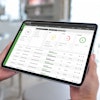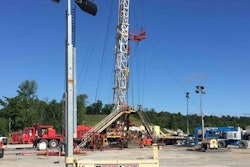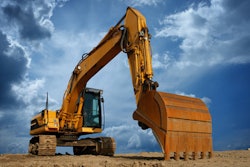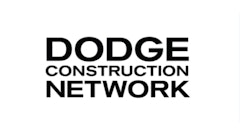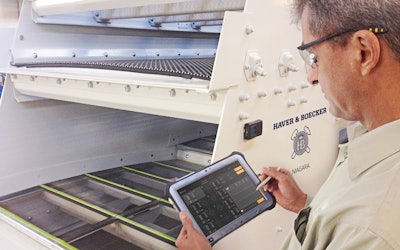
Global demand for aggregates and mining materials is on the rise with the industry facing an expected growth of nearly 4.2 billion tons over the next 15 years. That’s a lot of material, which means producers need efficient equipment to meet spec and turn a meaningful profit.
Every ton of material must go over at least one vibrating screen, so ensuring the equipment’s efficiency is critical to an operation’s success. The good news is that there are technologies available today that can help increase or improve screening productivity. Integrating cutting-edge systems like eccentric screening technology, state-of-the-art screen media and diagnostic tools can prevent blinding, pegging, carry-over or contamination, improving screening performance, productivity and profits.
Heighten Screening Action
Vibrating screens that are engineered with a double eccentric shaft assembly create a constant stroke to maintain g-force during material surging. The double eccentric shaft design forces the screen body to follow the movement of the shaft. While the shaft travels up, the counterbalance weights move in the opposite direction and create a force equal to what is generated by the body. As a result, the forces cancel each other out and maintain a consistent positive stroke that handles material volume spikes without losing momentum.
One producer in western Canada quickly saw the benefits of switching to double eccentric screening technology when they replaced two horizontal vibrating screens with one double eccentrically-driven, four-bearing inclined vibrating screen. Changing their equipment helped to eliminate surging, blinding, pegging and material contamination challenges while increasing their production by 25%.
Reduce Damaging Vibrations
A vibrating screen’s operation can have a large impact on a machine’s surroundings. The metal springs on a traditional concentric vibrating screen, for example, can be noisy to operate. This metal-to-metal, up-and-down or side-to-side movement can cause excessive noise and vibration. To resolve this problem, double eccentric technology makes use of shear rubber mounts that are strategically designed to minimize lateral movement. The rubber mounts reduce noise while maintaining smoother operation, even in extreme circumstances such as overloading, surging and starting or stopping under load.
The use of eccentric technology virtually eliminates vibration in the structure — or chassis when used with portable equipment — which protects the integrity of the machine. This means producers can potentially use multiple eccentric vibrating screens in one structure, boosting productivity. Attempting to operate multiple concentric machines in a structure, however, could create vibrations damaging enough to not only cause a negative effect on the quality of production but open the door to safety risks and possible downtime.
A leading phosphate producer in North America — producing nearly 8 million tons per year — increased screening area by 60 percent by transitioning to double eccentric equipment. The mine incorporates a six-story screening plant to house multiple vibrating screens that run 24/7. Multi-story screen houses are common in the industry but can pose structural concerns due to the vibrating screens’ size, capacity and force. Opting for double eccentric technology eliminated those concerns.
Improve Stratification
Combining the use of advanced eccentric screening technology with the best screen media for the application is a recipe for success. Specifically, polyurethane screen media can be a beneficial asset to any operation seeking to prevent blinding and pegging while improving material stratification and increasing wear life.
Polyurethane media offers the best combination of open area and wear life for both wet and dry applications. In particular, polyurethane screen media that is poured open cast can result in 1.5 to 2 times longer wear life than injection-molded products. Open cast polyurethane permanently hardens when cured to maintain its chemical properties and improve wear life. Alternatively, injection-molded screen media can soften when temperatures rise, resulting in shorter wear life. Polyurethane screen media also features tapered openings to reduce the risk of blinding and pegging.
The solution to improving material stratification lies in finding the ideal mix of screen media types to ensure all phases of screening work correctly. A screen media company that offers a variety of screen media types can help evaluate how material moves through the three phases of screening — from layered to basic to sharp — to give recommendations on the best screen media for an application. Producers can customize the screen deck by choosing screen media that maximizes productivity for each phase by blending the best combination of open area and wear life.
Prevent Equipment Damage
A vibrating screen needs regular checkups to run optimally. Vibration analysis and diagnostic systems designed specifically for vibrating screens by OEMs are reliable tools for maintaining continued efficiency and longevity of screening machines. To ensure the best productivity, operations can partner with an OEM that specializes not only in manufacturing equipment, but also offers additional diagnostic tools, product-specific knowledge and years of engineering experience.
Utilizing vibration analysis software, for example, allows mining and aggregates operations to monitor a vibrating screen’s performance in real-time by detecting problems before they lead to diminished performance, decreased efficiency and increased operating costs. The most robust systems incorporate eight wireless sensors that magnetically fasten to key areas of a vibrating screen and measure orbit, acceleration, deviations and other important data points that indicate the condition of the machine. The sensors send real-time information wirelessly to be analyzed, ideally by an OEM-certified service technician who can provide a detailed summary and recommendations.
Some manufacturers use vibration analysis technology to offer impact testing — or a bump test — which ensures proper machine calibration and promotes efficient operation. Impact testing involves striking the machine at key points with a dead blow hammer while the machine is off. Vibration analysis sensors are placed at key locations on the vibrating screen while a technician tests the natural frequency of a machine. Based on the results, engineers can adjust machine parameters to avoid operating in resonance, which can diminish productivity, incur damage to vibrating screens and pose safety risks. It is important to note that natural frequency can shift over time as components are repaired or replaced, so the impact test should be conducted regularly. By incorporating impact testing into an operation’s regular maintenance routine, producers can ensure optimum screening performance and equipment reliability.
Another advanced diagnostic tool is condition monitoring, which is designed to monitor the health of vibrating screens using modern algorithms and artificial intelligence. The system utilizes permanent sensors that monitor the equipment 24/7 to capture real-time information and provide alerts via e-mail immediately upon the first sign of a potential problem. By constantly monitoring the accelerations of the vibrating screen, certain systems can even forecast the equipment’s dynamic condition in regular intervals of 48 hours, 5 days and 4 weeks. With consistent use, condition monitoring software will accurately point out and predict critical issues and advise when to schedule maintenance, along with what to focus on during that planned downtime.
By using diagnostic programs to conduct regular analysis, and by engaging in predictive and preventative maintenance, operations will see minimized downtime through faster problem-solving, lower repair costs and increased peace of mind.
Increase Profits Through Advanced Technology
The development of the double eccentric screen and other screening technology provides operations with innovative and cost-effective ways to increase their profits and efficiency. By integrating the right equipment, screen media and vibration analysis systems, producers can see more uptime, higher quality results, increased productivity and greater profits.

